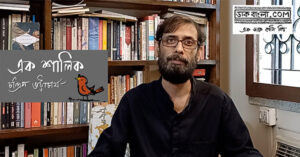My first film Apur Sansar with Satyajit Ray made me a household name in Bengal. But it came with a price. I had to leave my Bengali medium school in Kolkata, because the headmistress Ms Das felt that now that I had worked in a film, I would be a bad influence on the other girls in my class. So my parents made me enroll in Loreto Convent in Asansol, where they lived. It was quite difficult for me to let go of my friends and begin life in a new school, this time an English medium one. It was quite traumatic having to get used to a new language. I remember that the first essay I was given to write was ‘On a Windy Day’ and I wrote it in Bengali and then translated it almost word for word into English, with my grammar and syntax all haywire. I used to hide from people at school because conversations had to be in English.
It was during the school vacations the next year that Manik-da called me for Devi, which became my second film. I was fourteen at that time. It was made in 1959. Today, so many years, so many films later, it remains my favourite film, my favourite performance. Even the subject, set in 1860, in my opinion remains relevant today.
In the second half of the nineteenth century, the period in which Devi is set, the confrontation between Hindu orthodoxy and rational reformism was at its most intense. The conflict had permeated the zamindar class and many young reformers in fact originated from this class. It is no wonder that the germ of the theme of Devi was given by Rabindranath Tagore to Prabhat Mukherjee, who is credited with the story. The characters in Devi embody this conflict between blind Hindu superstition and the growth of cynicism and eventual revolt of the era. The father dominating his weak-willed elder son represents Hindu orthodoxy. The younger son, Umaprasad, represents the new generation influenced by Western learning and intellectualism. He studies in Calcutta and is influenced by the rational professor who advocates reformist thought. Yet, that this reformist voice wasn’t yet strong enough to stand up to the entrenched dogmatic beliefs and bigotry is clear when he arrives home upon receiving Harisundari’s letter. The chanting priests, the fervent crowd of worshippers and his father’s will hold him at bay.
Harisundari, the elder daughter-in-law, stands somewhere in the middle. She is a rational woman, yet unable to let go of centuries of orthodox conditioning.
When I read the script this time, I realized what an opportunity it would offer me in terms of performing. As far as I can discern, there isn’t a false note in the film, the sure way in which it moves to the shattering climax, the haunting music, the cinematography which heightens the mood of impending doom. The opening shots reveal the fervid religiosity of the zamindar, Kalikinkar Roy, almost setting the mood for what is to unfold. As the zamindar watches the Durga Puja as if in a trance, the incense shrouding the air, the cymbals and the drum on the soundtrack, it is impossible not to have a feeling of unease. One is immediately aware that one is in the presence of one intoxicated by faith.
I am immensely proud of this film. In fact, Manik-da also felt that Devi and Charulata were his favourite films because, as he himself said, he made less mistakes in these. Even today, when I go back to it, I am amazed at the skill with which Manik-da extracted such a performance from one who was still a novice. But then I guess that was his greatest ability, to make newcomers feel at ease and get them to emote the way he had envisaged a scene, without probably the actor even realizing it. That is why the performances in his films are so natural, they do not seem like performances at all.
Just watch the scene where the father-in-law comes running to Doyamoyee, muttering ‘Ma, ma’, after his dream where he sees Doya’s face and eyes morph into that of the goddess. He falls at Doya’s feet in abject worship, to be followed by Doya’s brother-in-law. The revulsion and fear that Doya experiences is depicted not by traditional cinematic forms. One sees her nails scratching the wall next to her even as her toes curl away and you know she is revolted by the spectacle, her very being brutalized and shrinking, a feeling that as a viewer I feel when I watch the film fifty years on.
In the absence of her Western-educated husband who stays in Calcutta, Doya is simply not strong enough to resist the fanatic will of the father-in-law. She is as much a victim of the patriarchal set-up in which she has grown up, where she has been taught not to question what is asked of her by the men of the house. Even as she is garlanded and decked up as goddess, one needs just a look at her face to know that she is full of doubts, though too timid, too-tradition bound, too young to assert her will of self-preservation. It is not long before the relentless assault of being worshipped disturbs her sense of reality as Ray proceeds to unfold the doom that is now Doya’s fate.
Somehow, the film’s set-up and character probably impacted me even during the shoot. In fact, unlike Apur Sansar, where I felt very energized on the sets, here I could not let go of a feeling of heaviness, of carrying a weight on my chest, going through an ordeal of some sort; much of it must have been because of all the make-up, the garland around my neck, but I also dare say that somehow the oppression that Doya probably felt had infected me, which worked for the character.
The film was widely misinterpreted in the West at the time. While everyone in Bengal is familiar with Kali worship and is aware of the nature of the orthodox Hindu family structure and its dos and don’ts, the Western audience was not, and therefore experienced a great deal of difficulty in following the course of events, as the development of the plot grows out of this orthodox Bengali nature of the theme.
Even in India, there was a lot of trouble at the time of its release. The film became quite controversial as it was seen as an attack on Hinduism. The government too seemed unwilling to promote a film that talked of what they deemed was outmoded superstition. More so, because Ray was a Brahmo, it was hinted that he had chosen the subject to attack Hinduism, which was not true at all. Manik-da had to clarify that the film was against the orthodoxy of Hinduism and not against Hinduism per se. Interestingly enough, about a fortnight after the subject was announced, there was a similar incident in western India, where a young village wife was declared to be a reincarnation of a minor local deity. I agree with Andrew Robinson, Ray’s biographer, who says that the film implies that it is humans who create and recreate gods and it is the human mind that decides whether they are used for the benefit of mankind or not.
If anything, the subject remains relevant even now, with dark pockets of ignorance and superstition still prevalent, not to speak of a societal order made by men where women are mere tools and end up as helpless victims. For one, in large sections of the population, a woman remains captive, she has no escape, no option. Two, she is mentally conditioned that whatever your family decides for you is the best for you, you are there to serve the family, you cannot have a mind of your own. In Devi, even when Umaprasad tells her to accompany him to Calcutta, she is unwilling to do so, thinking about her father-in-law, about the child. And even towards the end, she fails to let go of the myth of incarnation only because she is afraid that it might bring bad luck to her husband, as she says, ‘Jodi ami devi hoi, tomar jodi amangal hoy’. This thinking exists even now and religious dogmas kind of reinforce these. So, Devi continues to be relevant in the way it addresses the use of religious orthodoxy to victimize the woman. Underlying this is the need for education, the kind of education that fosters rational thinking, an issue that Ray, like Tagore, believed in and which informs both Apur Sansar and Devi.
Till such time that religion is used to perpetuate ignorance and superstition, till such time that the true tolerant, progressive nature of religion continues to elude mankind, Devi will remain extremely relevant and a must see for anyone who loves meaningful cinema.





